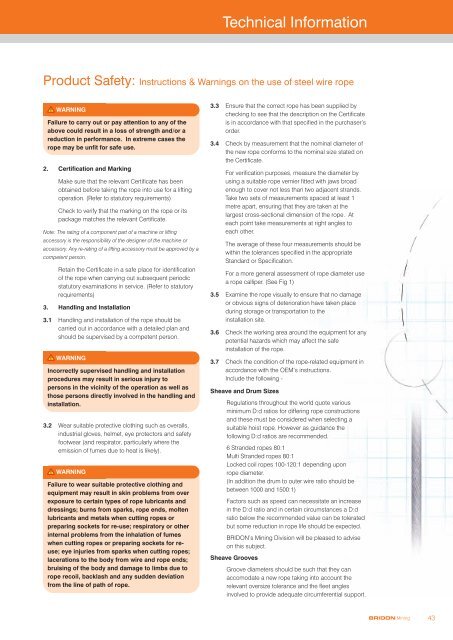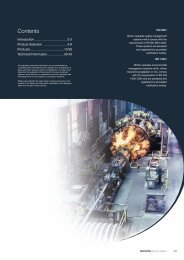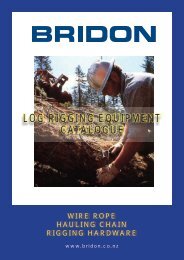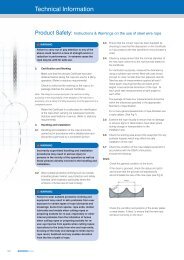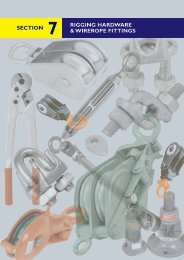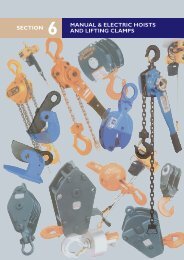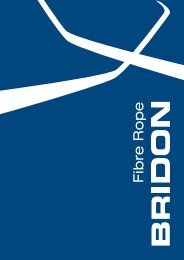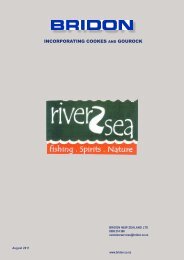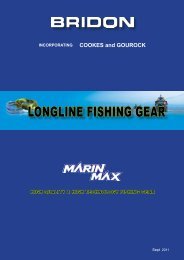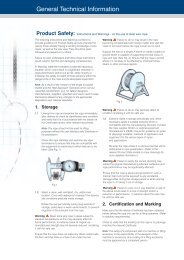You also want an ePaper? Increase the reach of your titles
YUMPU automatically turns print PDFs into web optimized ePapers that Google loves.
Technical InformationProduct Safety: Instructions & Warnings on the use of steel wire ropeWARNINGFailure to carry out or pay attention to any of theabove could result in a loss of strength and/or areduction in performance. In extreme cases therope may be unfit for safe use.2. Certification and MarkingMake sure that the relevant Certificate has beenobtained before taking the rope into use for a liftingoperation. (Refer to statutory requirements)Check to verify that the marking on the rope or itspackage matches the relevant Certificate.Note: The rating of a component part of a machine or liftingaccessory is the responsibility of the designer of the machine oraccessory. Any re-rating of a lifting accessory must be approved by acompetent person.Retain the Certificate in a safe place for identificationof the rope when carrying out subsequent periodicstatutory examinations in service. (Refer to statutoryrequirements)3. Handling and Installation3.1 Handling and installation of the rope should becarried out in accordance with a detailed plan andshould be supervised by a competent person.WARNINGIncorrectly supervised handling and installationprocedures may result in serious injury topersons in the vicinity of the operation as well asthose persons directly involved in the handling andinstallation.3.2 Wear suitable protective clothing such as overalls,industrial gloves, helmet, eye protectors and safetyfootwear (and respirator, particularly where theemission of fumes due to heat is likely).WARNINGFailure to wear suitable protective clothing andequipment may result in skin problems from overexposure to certain types of rope lubricants anddressings; burns from sparks, rope ends, moltenlubricants and metals when cutting ropes orpreparing sockets for re-use; respiratory or otherinternal problems from the inhalation of fumeswhen cutting ropes or preparing sockets for reuse;eye injuries from sparks when cutting ropes;lacerations to the body from wire and rope ends;bruising of the body and damage to limbs due torope recoil, backlash and any sudden deviationfrom the line of path of rope.3.3 Ensure that the correct rope has been supplied bychecking to see that the description on the Certificateis in accordance with that specified in the purchaser’sorder.3.4 Check by measurement that the nominal diameter ofthe new rope conforms to the nominal size stated onthe Certificate.For verification purposes, measure the diameter byusing a suitable rope vernier fitted with jaws broadenough to cover not less than two adjacent strands.Take two sets of measurements spaced at least 1metre apart, ensuring that they are taken at thelargest cross-sectional dimension of the rope. Ateach point take measurements at right angles toeach other.The average of these four measurements should bewithin the tolerances specified in the appropriateStandard or Specification.For a more general assessment of rope diameter usea rope calliper. (See Fig 1)3.5 Examine the rope visually to ensure that no damageor obvious signs of deterioration have taken placeduring storage or transportation to theinstallation site.3.6 Check the working area around the equipment for anypotential hazards which may affect the safeinstallation of the rope.3.7 Check the condition of the rope-related equipment inaccordance with the OEM’s instructions.Include the following -Sheave and Drum SizesRegulations throughout the world quote variousminimum D:d ratios for differing rope constructionsand these must be considered when selecting asuitable hoist rope. However as guidance thefollowing D:d ratios are recommended.6 Stranded ropes 80:1Multi Stranded ropes 80:1Locked coil ropes 100-120:1 depending uponrope diameter.(In addition the drum to outer wire ratio should bebetween 1000 and 1500:1)Factors such as speed can necessitate an increasein the D:d ratio and in certain circumstances a D:dratio below the recommended value can be toleratedbut some reduction in rope life should be expected.BRIDON’s <strong>Mining</strong> Division will be pleased to adviseon this subject.Sheave GroovesGroove diameters should be such that they canaccomodate a new rope taking into account therelevant oversize tolerance and the fleet anglesinvolved to provide adequate circumferential support.BRIDON <strong>Mining</strong>43


